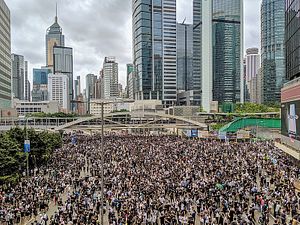Estonia and the other Baltic states, Latvia and Lithuania, achieved what most observers deemed impossible. Not only did they break from Kremlin domination in 1988-1991, but they survived and soon became integrated into both NATO and the European Union. Could Hong Kong follow this example — not only depart from Beijing’s rule but survive and prosper on the world stage? Most experts say no, but they could be wrong.
Hong Kong today is much stronger economically than any of the Baltic states in the 1980s. The economies of each Baltic republic were controlled from Moscow. None was self-sufficient; each was deeply interdependent with the rest of the USSR. None produced goods or services that met western European standards.
In contrast to the Baltic states, Hong Kong is an entrepot between China and the world. This role might weaken if Hong Kong became independent but both parties would continue to need each other. Political differences do not keep Singapore and Taiwan from intense commercial ties with China. Western businesses would feel more secure investing in an independent, law-respecting Hong Kong.
Is Hong Kong too small to function as a city-state? No. Hong Kong has more than 7.4 million people — many times the 1.3 million of Estonia. Indeed, Hong Kong’s population exceeds that of all three Baltic republics combined. Taiwan is three times larger with 24 million people, but Singapore’s population is just 5.6 million.
Hong Kong’s territory covers only 1,104 square kilometers of land, while each Baltic republic (as well as Taiwan) has at least 40 times the territory. Yet Singapore thrives even though its land mass now covers only 722 sq km. In previous centuries, Hanseatic League city-states such as Hamburg, Gdansk, Riga, and Dorpat (Tartu) prospered as independent republics governed by mercantile elites.
Why should Hong Kongers want to be independent? Most are ethnically Chinese, but their identities — as in Taiwan and Singapore — have become different from those of mainland Chinese. Most Hong Kongers grow up speaking Cantonese and resent pressures to use Mandarin. They write and read using traditional Chinese characters rather than the simplified script imposed by Beijing. A large percentage is fluent in English. All enjoy free access to the internet and other media, linking them to ideas and facts not available to most Chinese. A survey in 2016 showed that nearly 40 percent of Hong Kongers aged 15 to 24 wanted independence along with 17.4 percent of Hong Kongers overall, but that only 3.6 percent believed it possible. Recent allegations of police brutality against protesters probably boosted pro-independence sentiments though there is also wide revulsion at the forced entry into the Legislative Council by radical protesters.
How Great Britain seized Hong Kong in the mid-19th century was disgraceful, but its colonizers imparted a legacy of law, education, and fair play that differs sharply from the top-down ways of Communist China. Some people hoped that Hong Kong’s liberal values might modify Communist Party rule. Under President Xi Jinping, however, China is becoming a technocratic version of Mao Zedong’s totalitarian dictatorship.
How did David defeat Goliath in the Baltic? Worn down by eight years in Afghanistan, the Kremlin’s imperial will weakened in the 1980s. Exploiting Mikhail Gorbachev’s perestroika and glasnost programs, non-communist cultural figures such as Lennart Meri in Estonia and Vytautas Landsbergis in Lithuania helped organize a nonviolent “Singing Revolution.” Huge crowds marched in the streets and sang native songs. The Popular Fronts demanded that Moscow honor the Soviet constitution provision granting each republic the right to self-determination. They asserted that Baltic republic laws trumped dictates made in Moscow. Soviet military units based in the Baltic attacked demonstrators just once, in Vilnius, killing fewer than 20. Soon the Soviet legislature recognized that Estonia, Latvia, and Lithuania were self-governing and no longer belonged to the USSR. Other Soviet republics adopted Baltic tactics. In December 1991 the USSR collapsed and all 15 union-republics became independent.
Meanwhile, Chinese leaders in June 1989 faced strong demands for democracy by demonstrators in Tiananmen Square. Having deliberated, the regime proceeded to kill between one and two thousand demonstrators. Surely Beijing authorities today are determined to preserve “stability,” but such large-scale blood-letting may no longer be a viable option.
China is now stronger in most ways than the USSR in the Gorbachev era, but it stands on feet of clay. Labor unrest and ethnic-cultural dissent flare widely. Intellectuals and some businesspeople are demanding more freedom. Discontent at Han intrusions is growing among Tibetans, Kazakhs, Uyghurs, and Mongolians. Air pollution is increasingly causing public anger, as are shortages of clean water.
If such problems multiply and Hong Kongers remain persistent, they might catch the Estonian dream — not today, but perhaps in a decade. But nothing is pre-determined They will need widely respected leaders like Estonia’s Lennart Meri plus what is now lacking — a Chinese Gorbachev.
Walter Clemens is an Associate at the Harvard University Davis Center for Russian and Eurasian Studies. He wrote Baltic Independence and Russian Empire (1991) and The Baltic Transformed (2001). He is Book Review Editor at the journal Asian Perspective.

































